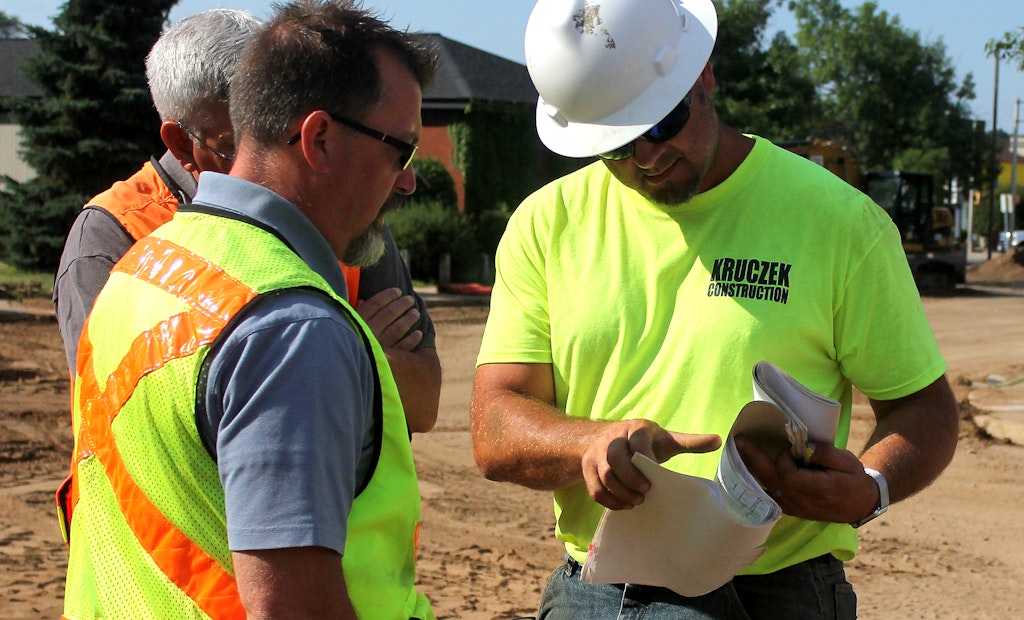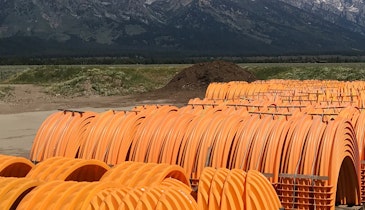
Interested in Stormwater?
Get Stormwater articles, news and videos right in your inbox! Sign up now.
Stormwater + Get AlertsWhen Kruczek Construction took on Rhinelander, Wisconsin's Downtown Streetscape Project last year, the work itself wasn’t unusual for the general contractor. Kruczek typically takes on between $15 million and $20 million worth of work in a calendar year, much of it involving replacing underground pipe in downtown areas. What was unusual was the scope of the project.
“We normally do jobs that are $2 million or $3 million apiece, and we’ll do multiple of those types of jobs in a year. We’ll spend a month or two on a job and go to the next one,” says Sean McNamara, vice president of Kruczek Construction. “But this was upward of $7 million all at one time. A job this size, where we were doing 21 blocks of a downtown area, to look at it on paper and be able to transfer it to the field and come up with a day-to-day game plan was a big learning experience, but a good one.”
Here’s how Kruczek, alongside the engineering firm on the project, Town & Country, tackled the daily tasks while still keeping the overall project in mind.
EVERYTHING IS A PROGRESSION
McNamara says breaking everything down into steps was key for staying on track with the larger project.
“Everything is a progression,” he says. “We did the deepest pipes first and then worked our way up to the shallowest — sanitary sewer being the deepest for the most part, then water mains, then storm sewers. We’d mostly plan it out weekly and then come up with our daily plans. And as we finished an area, the subcontractors would come in and do the roadwork, and then put curb and gutter down, and then sidewalk. So that was all a progression as well.”
McNamara says he had three crews on the project, each with a foreman. He stayed in regular communication with his foremen, and met with them to start and end each workday, which helped with making any adjustments to the overall schedule.
“It was a pretty big animal to try to plan. I got a lot of help from my foremen,” McNamara says. “I pretty much dictated with those three guys and then they took care of their own crews. Every day we’d assess how we did and then make a plan for the next day so we could get started right away in the morning.”
GETTING ALL THE PLAYERS INVOLVED
In addition to communicating effectively with his three foremen on a daily basis, McNamara says weekly meetings involving all the key players on the project were important — the engineering firm, subcontractors, utility companies and city officials. During the project, a meeting was held every Thursday afternoon at Rhinelander’s wastewater treatment plant.
“We would talk about the progress of the previous week and then the plans for the following week, and even try to go out a little over the next month,” McNamara says. “It got everybody on the same page, so that we could keep moving forward with the project and avoid delays. It was a lot of people to coordinate with, between the engineers and the people doing all the marking and staking out in the field, so that things were ready for us and we could get in an area and get going.”
Adds Mark Barden, engineer with Town & Country Engineering: “It really becomes important on a project this size where we had so many people involved — the contractor, we had interns and a construction manager out there, and myself, and the subcontractors and the utility companies. There were so many people involved in making this project run smoothly, it was nice to get everyone together in one room and talk about things instead of having individual conversations that not everyone is clued in on. We got everyone on the same page. It was a good coordination tool for everyone.”
The weekly meetings were also an opportunity to address any concerns from the public.
“Following the meetings, we’d put out an update on the website for the public, so a lot of that information going out to the public came from those meetings,” Barden says. “And if there were specific concerns with business owners as far as deliveries or water shut-offs that may have influenced a restaurant or catering service, we tried to address that and get scheduling down to accommodate that at the meetings.”
STRAYING FROM THE PLAN
Despite extensive advanced planning, issues came up that altered the schedule during the course of the project, whether it was weather canceling a day of work, an unforeseen underground obstruction delaying progress temporarily, or a utility company’s schedule for their portion of work conflicting with Kruczek’s plans.
“The schedule got adjusted daily,” McNamara says. “There was always a forecast of what we felt like we were going to get done and then what actually happened. But we tried to forecast as much as we could.”
McNamara says a key was being prepared to move to a different portion of the project if a problem arose in another area.
“If we suddenly ran into a utility that was in our way, like a gas line or a telephone line, and needed to have someone come in to move it out of our way, we’d just leave that and work on something else for the day,” McNamara says. “We were always looking ahead at what we could do if we needed to jump around. There was always plenty to do.”
For the planned work of subcontractors and utility companies, McNamara says a week or two of notice was given for when Kruczek was going to be working in an area. The subs and utility companies either went in ahead of Kruczek or followed.
“It was an in-and-out type thing. They’d move along the job with us,” McNamara says. “It was challenging sometimes, but mostly everything went smoothly. They’d tell us what they’d need to do, and we’d tell them when they could come in so we could be sure we were out of their way.
“Overall, it was very minor adjustments we had to make. For the most part we tried to stick with our plan, but we stayed flexible to make minor adjustments if we ran into unforeseen circumstances. We ended up being on target for the most part each week.”
For additional coverage on the Rhinelander Downtown Streetscape Project, go to www.mswmag.com/Rhinelander.





